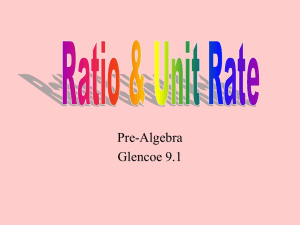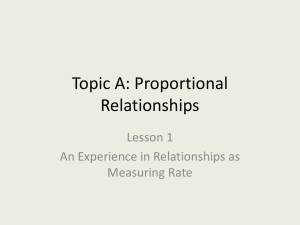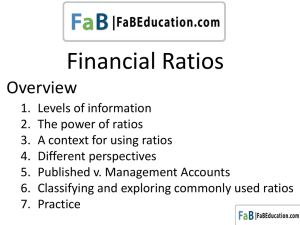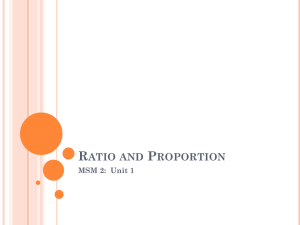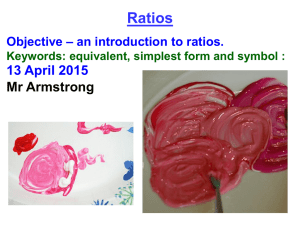Ratios 5_1 - Alliance Christine O`Donovan Middle Academy
advertisement
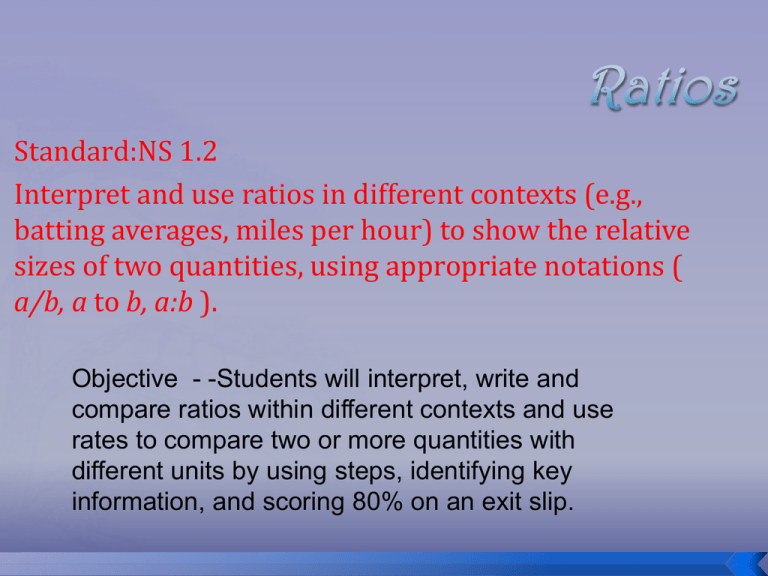
Standard:NS 1.2 Interpret and use ratios in different contexts (e.g., batting averages, miles per hour) to show the relative sizes of two quantities, using appropriate notations ( a/b, a to b, a:b ). Objective - -Students will interpret, write and compare ratios within different contexts and use rates to compare two or more quantities with different units by using steps, identifying key information, and scoring 80% on an exit slip. Observe, Question, Comment 1/11/10 Lesson 5-1: Pg. 194, # 12-16 & # 23-25 1/11/10 Lesson 5-1: Ratios [Pg. 192-195] Hook: 36L 36R Discuss with your partner: How do the number of white keys compare to the number of black keys? Observe, Question, Comment 1/11/10 Lesson 5-1: Pg. 194, # 12-16 & # 23-25 1/11/10 Lesson 5-1: Ratios [Pg. 192-195] Hook: Standards/ Objective: 35L 35R Standards: Number Sense 1.2***: Interpret and use ratios in different contexts (e.g., batting averages, miles per hour) to show the relative sizes of two quantities, using appropriate notations (a/b, a to b, a:b). Learning Targets: 5A: Describe a ratio in your own words. 5B: Give a variety of examples of ratios written in different ways (a/b, a to b, a:b). 5C: Represent a real life situation using a ratio and explain the connection between the situation and the mathematical model. Can you explain what the learning targets mean? What will you be able to do by the end of this lesson? Ratio: Ratios are used to compare two quantities using division. Observe, Question, Comment 1/11/10 Lesson 5-1: Pg. 194, # 12-16 & # 23-25 1/11/10 Lesson 5-1: Ratios [Pg. 192-195] Hook: Standards/ Objective: Notes/ Examples: 35L 35R Ratios can be used to: Compare a part to a whole. 1 rectangle to 7 shapes Compare a whole to a part. 7 shapes to 6 triangles Compare a part to a part. 1 rectangle to 6 triangles Compare a whole to another whole. 7 shapes to 4 shapes There are 12 boys and 10 girls in a class. The classroom has 24 desks. Use ratios to compare: A part to a whole: Boys to all students A whole to a part: All students to girls A part to a part: Girls to boys A whole to another whole: Students to classroom desks Example 1. The photo on the left shows one block of a music keyboard’s key pattern. The keys have a repeating pattern of five black keys and seven white keys. Use ratio to describe the pattern. Number of black keys: 5 Number of white keys: 7 The ratio of black keys to white keys is 5 to 7. This means that for every 5 black keys, there are 7 white keys. There are 3 ways to write this ratio. 5 to 7 5/7 5:7 The photo on the left shows a piece of a quilt called a block. Compare the number of blue squares to the number of purple squares. Number of blue squares: 12 Number of purple squares: 9 The ratio of blue to purple squares is 12 to 9. This means that for every 12 blue squares, there are 9 purple squares. There are 3 ways to write this ratio. 12 to 9 12/9 12:9 Example 2. 1. 2. 3. Write each ratio in three ways. Use the pattern shown. Green squares to blue squares Red squares to blue squares Green squares to all squares Example 3. Two ratios that name the same number are equivalent ratios. You can find equivalent ratios by writing a ratio as a fraction and finding an equivalent fraction. The Identity Property of Multiplication states that you can multiply a number by 1 and not change its value. Is this true? For this reason, when 1 is written in a different form, such as a fraction like 3/3 or 5/5, and then multiplied with another fraction, the value of the fraction remains the same. 2/ = 2/ x 4/ = 8/ 3 3 4 12 You can also divide to find equivalent fractions. 12/ = 12/ ÷ 3/ = 4/ 15 15 3 5 http://www.mathsisfun.com/equivalent_fr actions.html Find a ratio equivalent to 4/5. 4 = 4 x 2 = 8 Multiply the numerator and 5 5 x 2 10 denominator by 2. Write 2/20 as a ratio in simplest form. 2 = 2 ÷ 2 = 1 Divide the numerator and 20 20 ÷ 2 10 denominator by the GCF, 2. Find a ratio equivalent to 7/9. Write 10/2 as a ratio in simplest form. Example 4. Write two ratios equivalent to 14/4. Use multiplication to write one and division to write the second. Example 5. Are the ratios equivalent? Write = or ≠ in the O. 5:8 3/12 4/6 9 to 8 O O O O 15:24 9/36 16/20 45 to 40 Example 6. Are these equivalent ratios? 19 10 505 255 If they are equivalent (showing the same number just in different form), then dividing them should result in the same decimal. For example: 5 8 0.625 = 15 24 0.625 So… 19 10 1.9 505 255 ≠ 1.98 Since 1.98 is not equal to 1.9, these are not equivalent ratios. Tell whether the ratios are equivalent or not equivalent. 7:3 and 128:54 180/240 and 25/34 Example 7. The ratio of girls to boys enrolled at King Middle School is 15:16. There are 195 girls and 208 boys in Grade 8. Is the ratio of girls to boys in Grade 8 the same as the ratio of girls to boys in the entire school? Example 8. Tell whether the ratios are equivalent or not equivalent. 12/24 and 50/100 1 to 3 and 2 to 9 2:3 and 24:36 Example 9. Observe, Question, Comment 1/11/10 Lesson 5-1: Pg. 194, # 12-16 & # 23-25 1/11/10 Lesson 5-1: Ratios [Pg. 192-195] Hook: Standards/ Objective: Notes/ Examples: Vocabulary: 35L 35R Own Definition: What is a ratio? What are the three ways a ratio can be written? Give an example. Class Definition: A comparison of two quantities. Notation [how you can write a ratio]: (1) 16 to 10 (2) 16:10 (3) 16/10 Own Definition: What are equivalent ratios? How are they created? Class Definition: Ratios that represent the same value, even if they do not look the same. They are created by multiplying or dividing both terms of the ratio by the same number. Observe, Question, Comment 1/11/10 Lesson 5-1: Pg. 194, # 12-16 & # 23-25 1/11/10 Lesson 5-1: Ratios [Pg. 192-195] Hook: Standards/ Objective: Notes/ Examples: Vocabulary: Moral of the Story: 35L 35R •In one sentence, what was the most important thing you learned from this lesson? • Math Link: How will you use ratios in the real world?


